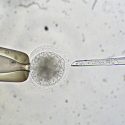Study finds variable drug sensitivity among hepatitis C viruses
Hepatitis C infection presents many patients with a troubling Catch-22 situation.
Chronic infection with the hepatitis C virus (HCV) is the leading reason patients receive liver transplants today. Unfortunately, infection of the new liver by residual HCV in the blood is inevitable, and the immune system suppression crucial to prevent transplant rejection can worsen HCV-mediated disease in transplant patients.
Now, a study from the University of Wisconsin–Madison School of Medicine and Public Health offers new promise for a double-duty treatment that may provide both immune suppression and anti-HCV activity in a single drug.
A common immunosuppressive drug, called cyclosporine A, has hinted of such antiviral activity – at least in a lab dish – but past clinical studies have not shown conclusive evidence that it effectively fights HCV in patients.
"The thought was that maybe cyclosporine was doing something good because it has this antiviral activity, but in fact the clinical data doesn’t really support that very well," says Robert Striker, UW–Madison professor of medicine and medical microbiology and immunology, who led the new study.
In spite of past unconvincing clinical studies, the circumstantial evidence is strong enough to have kept many scientists intrigued. For example, another immunosuppressant, tacrolimus, has largely replaced cyclosporine for transplant patients in recent years – a time period also marked by a trend toward poorer post-transplant recovery of HCV-infected patients.
The Wisconsin study, which was published online June 28 in the journal Hepatology, provides new support for anti-HCV effects of cyclosporine – plus a possible reason why previous studies may have missed it.
By monitoring the evolution of cyclosporine resistance, the group discovered that HCV forms with slight genetic differences – varying at only a handful of their 9,000 genetic bases and in just two proteins – have dramatically different sensitivities to cyclosporine.
HCV is highly genetically variable, Striker says – in fact it is the most variable virus known, meaning that many different versions exist with slightly different genetic sequences.
The new finding suggests that patients with cyclosporine-sensitive HCV variants may show antiviral benefit from cyclosporine treatment, while those with resistant variants would not.
"One of the more exciting aspects of this study is that it fits some data already [known] that in fact there is an effect from cyclosporine but that it is a genotype- or strain-specific effect," says Striker.
Naturally occurring genetic variations may have masked the effects of cyclosporine against HCV in previous clinical trials, he says. "This study reveals a complexity of the issue that was previously not studied very rigorously."
Though the results from the current analysis are too preliminary to determine whether individual patients should switch drug regimens, he suggests that more rigorous investigations are needed that will take into account viral variability and differential drug sensitivities.
The high degree of HCV variability means there will probably never be a one-size-fits-all treatment, but rather that many factors will likely play important roles in deciding the best course of action for an individual patient, including which viral strain is involved and which drugs are used.
"We don’t know how important these factors are in patient care right now, but they are impacting decisions that are made right now," Striker says.
Understanding how cyclosporine acts against HCV should help doctors choose complementary drug combinations to reduce the development of drug resistance, Striker says, while the specific proteins identified – important in viral replication – offer a novel target for antiviral drugs.
"Slightly altered versions of cyclosporine that may be better as antivirals are in clinical trials now," he says. "This paper strengthens the rationale to give these compounds a chance."
Funding for this work was provided by the UW–Madison School of Medicine and Public Health from "The Wisconsin Partnership Fund for a Healthy Future" and by the National Institutes of Health and American Cancer Society.



